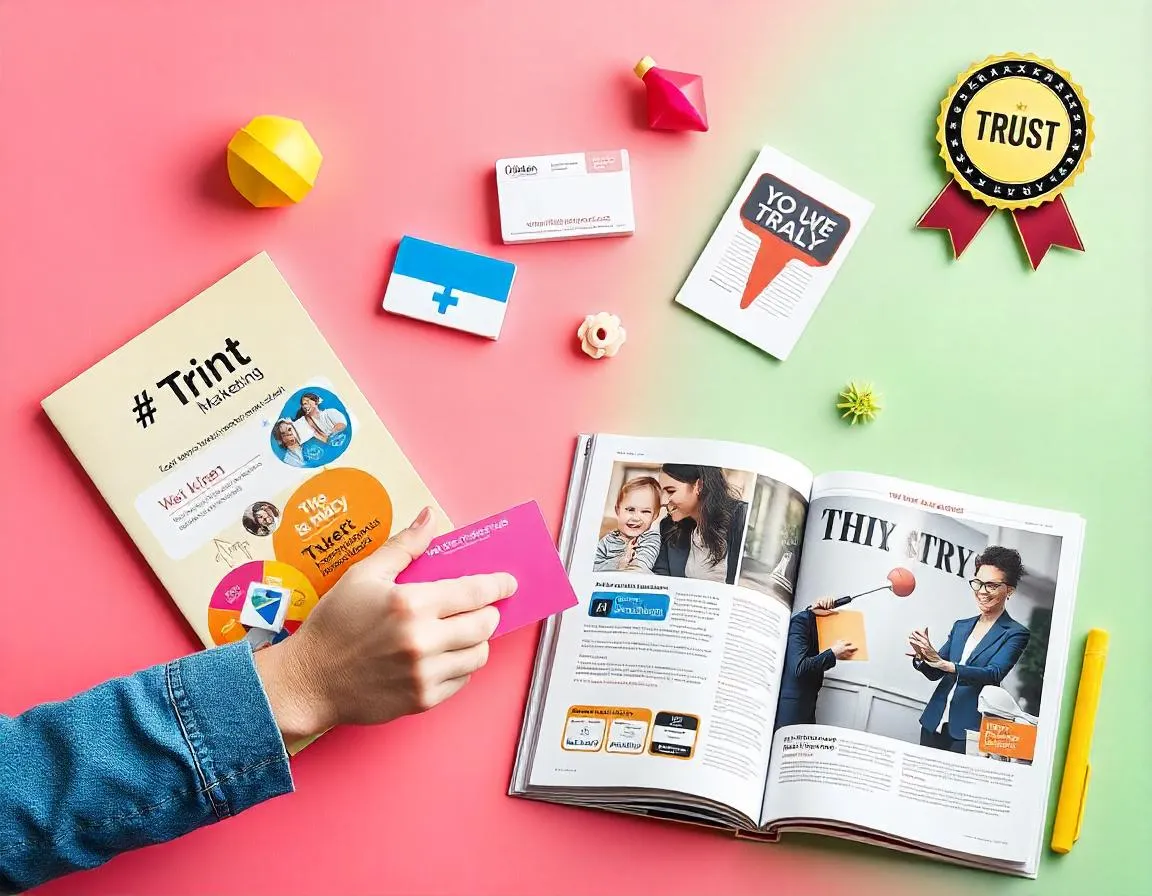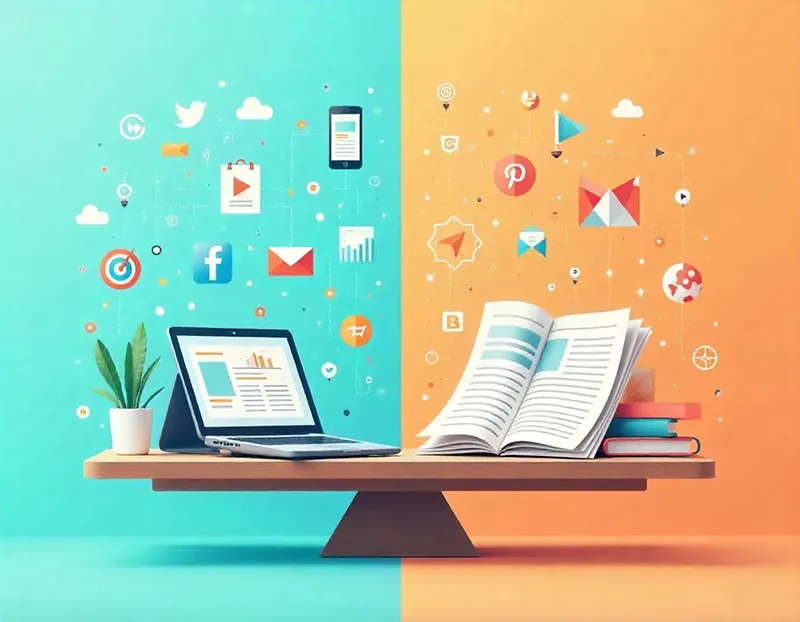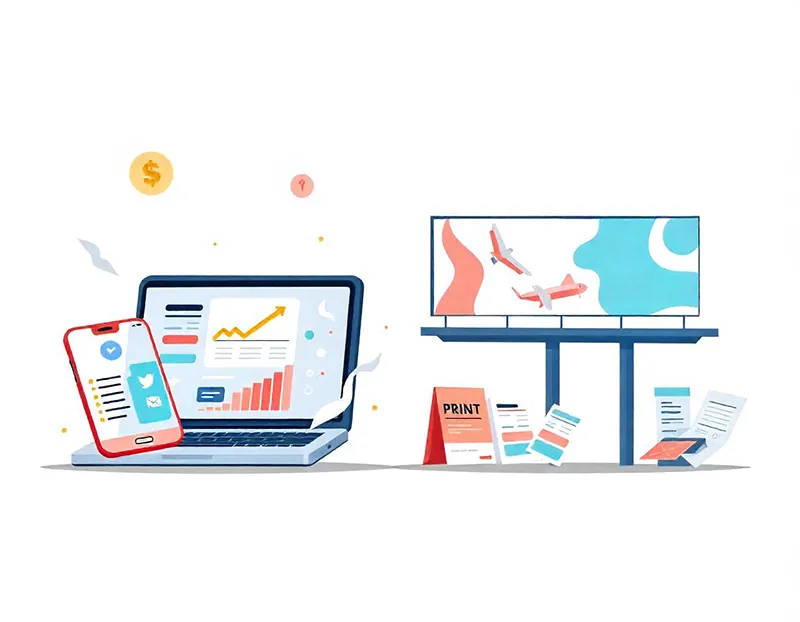Marketing has evolved significantly over the years, with businesses debating between digital marketing vs. print marketing. Both approaches offer unique advantages, and the best choice depends on factors like target audience, cost, and return on investment (ROI).
This article explores the strengths, weaknesses, costs, audience engagement, and future trends of digital and print marketing, helping businesses make informed decisions.
Digital Marketing vs. Print Marketing: A Side-by-Side Comparison
Both digital marketing and print marketing play crucial roles in modern business strategies. While digital marketing thrives on instant engagement and measurable results, print marketing continues to be a strong player in creating lasting brand impressions. Below is a detailed comparison of their strengths and weaknesses, helping businesses decide which approach—or combination—works best.
Strengths of Digital Marketing
Real-Time Engagement
One of the biggest advantages of digital marketing is its instant connectivity. Businesses can reach their audiences through social media, email marketing, Google Ads, and influencer collaborations, getting immediate feedback and interaction.
For example, a business running a social media campaign can track shares, comments, and likes in real time, allowing for quick adjustments. Email marketing campaigns can be A/B tested to see which message gets better engagement.
💡 Pro Tip: Businesses in the UAE can maximize real-time engagement by using PPC Campaign Management and Google Ads Management services, ensuring their campaigns reach the right audience instantly.
Targeted Advertising
Unlike print marketing, where the same material is distributed to a broad audience, digital marketing allows hyper-targeted ads. With data analytics and AI-powered insights, businesses can narrow down their audience by age, location, interests, online behavior, and purchasing patterns.
For example, a real estate company in Dubai can use Google Ads or Facebook Ads to target individuals actively searching for property investments in the UAE. Meanwhile, an e-commerce store can retarget website visitors with personalized ads, increasing the chances of conversions.
💡 Key Insight: Companies looking to optimize their digital marketing strategy should invest in Search Engine Optimization (SEO) services to attract organic traffic while running social media marketing campaigns for increased visibility.
Cost-Effective
Running digital marketing campaigns is often cheaper than print marketing. Businesses can start with small budgets and scale their spending based on performance.
For example:
- A Facebook ad campaign can start from as little as $5 per day, allowing businesses to test different audiences and optimize accordingly.
- An email marketing campaign costs significantly less than printing and distributing thousands of brochures.
Additionally, many digital marketing channels, such as organic SEO, offer long-term results without continuous spending.
💡 Smart Move: Businesses aiming to reduce marketing costs while maximizing reach can benefit from Complete Web Development & SEO Packages, ensuring high search engine rankings and continuous traffic.
SEO for Long-Term Reach
Unlike paid ads, Search Engine Optimization (SEO) provides sustainable growth. A well-optimized website can attract organic traffic for months or even years, reducing the need for expensive advertising.
For instance, a local bakery in Abu Dhabi can use SEO-friendly blog posts, Google My Business optimization, and keyword-focused web pages to appear at the top of search results when customers look for “best cupcakes in Abu Dhabi.”
💡 Pro Tip: Businesses that want long-term online success should invest in WordPress Website Maintenance & Updates to keep their sites optimized and running smoothly.
Weaknesses of Digital Marketing
Ad Fatigue
With millions of online ads competing for attention, consumers often ignore or scroll past digital advertisements. Banner blindness is a real issue, where users subconsciously skip over ads on websites.
For example, a user on Instagram may see dozens of promotional posts daily, leading to low engagement on repetitive or intrusive ads.
💡 Best Practice: Businesses should focus on high-quality content creation rather than overwhelming audiences with excessive ads. Services like Social Media Content Creation can help brands stand out with engaging and creative content.
Trust Issues
Many users distrust online ads, especially those that feel spammy or misleading. 47% of internet users actively use ad blockers, preventing them from seeing PPC and display ads.
Email marketing also suffers from trust issues, as users often ignore promotional emails. Poorly executed email marketing strategies can lead to high unsubscribe rates and spam complaints.
💡 Solution: Businesses should build credibility through consistent branding, valuable content, and customer engagement. High-quality Custom Website Design & Development can help companies establish trust and professionalism.
Strengths of Print Marketing
Tangible and Memorable
Unlike digital ads, which disappear with a click, print marketing materials are physical and lasting. A well-designed brochure, business card, or catalog remains in a customer’s hands, increasing the chances of recall and action.

Strengths of Print Marketing
For example:
- A luxury car dealership handing out premium brochures at an auto show leaves a lasting impression.
- A real estate agency giving professionally printed business cards creates credibility during client meetings.
💡 Enhance Your Brand: Businesses looking for professional print materials should consider Business Card Design & Printing, Brochure Design & Printing, and Custom Packaging Design & Printing services to make a lasting impact.
Higher Trust Factor
Consumers perceive print advertising as more trustworthy than digital ads. Studies show that 56% of customers trust print ads more than online promotions.
This is especially true for high-end industries, such as luxury brands, finance, and real estate, where credibility and exclusivity are important.
💡 Pro Tip: To strengthen brand credibility, businesses can use Letterhead & Envelope Design & Printing services to create professional business communication materials.
Better Retention
Research shows that people retain printed information better than digital content. A physical catalog or branded booklet engages the senses, making it more memorable than a fleeting online ad.
For example:
- A restaurant printing flyers and menus for home delivery services ensures potential customers see their brand multiple times.
- A fashion brand mailing out exclusive seasonal catalogs keeps its customers engaged for months.
💡 Best Strategy: Combining print and digital marketing—such as using QR codes in brochures or posters—creates seamless cross-channel engagement.
Weaknesses of Print Marketing
Higher Production Costs
Unlike digital marketing, where creating a social media post or Google ad takes minutes, print marketing requires physical production costs. Expenses include:
- Designing and printing materials
- Paper and ink costs
- Distribution fees (mailing, in-store placement, etc.)
For businesses with tight budgets, printing large volumes of materials can be expensive.
💡 Cost-Effective Alternative: Brands looking for affordable print solutions can explore Flyer Design & Printing, Banner Design & Printing, and Poster Printing services, which provide high-impact marketing at competitive prices.
Limited Tracking
With digital marketing, businesses can track performance using analytics tools. However, print marketing lacks instant feedback. While businesses can use promo codes, QR codes, or surveys to measure success, tracking effectiveness is still more difficult than in digital campaigns.
💡 Smart Strategy: Businesses can combine print with digital marketing by including custom landing pages or discount codes in print materials, allowing for better tracking.
Slower Implementation
Printing and distributing materials take time compared to instant digital advertising. While a Google Ads campaign can be set up in a day, designing, printing, and mailing flyers can take weeks.
💡 Solution: Businesses can speed up the process by using ready-made design templates or working with professional printing services like Media Print UAE, ensuring quick turnaround for marketing materials.
Both digital and print marketing have unique advantages. The best approach depends on your audience, budget, and business goals. For maximum success, combining both can create a well-rounded, high-impact marketing strategy. 🚀
Cost Comparison: Print vs. Digital Marketing
Print Marketing Costs
Print marketing costs depend on factors such as design, printing, distribution, and material quality. Businesses often invest in:
- Business cards, brochures, and flyers – Affordable but require bulk printing for wider reach.
- Catalogs and booklets – More expensive but effective for high-end brands and luxury product showcases.
- Billboards and signage – Costly but effective for local and long-term brand visibility.
- Mail campaigns – Include printing, envelope costs, and postage fees, making it pricier than digital alternatives.
💡 Budget-Friendly Tip: Businesses in the UAE looking for affordable print marketing can use services like Business Card Design & Printing, Flyer Design & Printing, and Brochure Printing from Media Print UAE to create high-impact materials at competitive prices.
Digital Marketing Costs
Unlike print marketing, digital marketing is more flexible in terms of budget and scalability. Costs vary depending on:
- SEO (Search Engine Optimization): A long-term investment that delivers organic traffic without recurring costs.
- PPC (Pay-Per-Click) Advertising: A highly targeted ad system where businesses only pay when users click. Budgets can be as low as $5 per day, making it accessible for startups.
- Social Media Marketing: Costs depend on ad budgets and content creation expenses.
- Email Marketing: More affordable than direct mail, with higher ROI when done correctly.
💡 Best Digital Approach: Businesses wanting to scale online efficiently should consider PPC Campaign Management, Social Media Marketing, and SEO Services for targeted, cost-effective digital reach.
ROI Breakdown: What Delivers Better Returns?
Digital Marketing ROI
One of the biggest advantages of digital marketing is real-time data tracking. Businesses can measure:
- Website visits and conversion rates (Google Analytics)
- Ad performance (Facebook Insights, Google Ads Dashboard)
- Email open and click-through rates (Email Marketing Software)
- Customer behavior and lead tracking (CRM tools)
Since digital campaigns are highly targeted, they often result in higher ROI for lead generation and conversions.
Print Marketing ROI
Although harder to track, print marketing still delivers impressive engagement rates.
- Direct mail campaigns achieve response rates of 9%, compared to 1% for digital ads.
- Print ads in newspapers/magazines generate higher recall than digital ads.
- Branded materials (brochures, catalogs, business cards) enhance credibility and increase customer retention.
💡 Pro Tip: To measure print marketing ROI, businesses can integrate QR codes, personalized URLs, or discount codes in print materials, making tracking easier.
Best Practices for Maximizing ROI
Digital Marketing Best Practices
To maximize digital marketing ROI, businesses should:
- Leverage multi-channel marketing – Use SEO, PPC, email, and social media together for better audience engagement.
- Invest in content marketing – High-quality blogs, videos, and social media posts increase brand authority.
- Use data-driven marketing – AI-powered tools help optimize ad spend and campaign performance.
💡 Need expert digital solutions? Complete Web Development & SEO Packages can help businesses rank higher in search engines and attract consistent traffic.
Print Marketing Best Practices
For effective print marketing, businesses should:
- Ensure high-quality print designs – Poorly printed materials can hurt brand credibility.
- Use personalization – Tailor materials to specific audiences for better engagement.
- Integrate with digital strategies – Add QR codes, personalized URLs, or NFC technology to drive users online.
💡 Smart Investment: Letterhead & Envelope Design, Custom Packaging, and Sign Boards can strengthen branding and credibility, making businesses stand out in the UAE market.

Print Materials Enhance Trust
Integrated Marketing: How to Combine Digital and Print for Maximum Impact
A hybrid marketing approach that combines both print and digital strategies can significantly boost brand engagement. Here’s how businesses can effectively integrate both.
Examples of Successful Integrated Campaigns
Coca-Cola’s ‘Share a Coke’ Campaign
- Strategy: Coca-Cola replaced its brand name on bottles with popular names, encouraging people to find their name and share it online.
- Print-Digital Integration: The campaign used custom-printed bottles and social media engagement to drive massive interaction.
Dove’s ‘Real Beauty’ Campaign
- Strategy: Dove ran a series of print ads and online videos featuring real women instead of models.
- Impact: The campaign generated widespread discussions, proving that integrating print with digital storytelling enhances brand trust.
Retail & E-commerce Brands
Many companies now use print catalogs to drive traffic to their online stores.
- Example: Luxury brands send printed catalogs with QR codes linking to product pages.
- Result: Customers engage with the print material before making an online purchase.
💡 Best Approach: Businesses can use Branded Print Materials (brochures, catalogs, business cards) alongside Social Media and SEO strategies for a well-rounded marketing plan.

Digital Meets Print for Maximum Impact
Strategies for Blending Digital and Print
QR Codes & Augmented Reality (AR)
Adding interactive features to print materials makes them more engaging.
- QR codes in brochures can link to exclusive web content or promotional offers.
- AR technology in catalogs allows customers to view 360-degree product previews before buying.
💡 Creative Idea: Businesses can add QR codes on banners, flyers, or custom packaging to direct customers to their Instagram shop, website, or exclusive digital promotions.
Cross-Promotion
Print and digital marketing should work together rather than compete.
- Use branded print materials (posters, flyers, roll-up banners) to direct traffic to websites and social media pages.
- Include social media handles on business cards and brochures for a seamless transition.
💡 Practical Application: A real estate agency can use branded brochures with QR codes leading to a virtual property tour, making it easier for potential buyers to explore listings.
Branded Print Materials
A strong brand identity relies on consistency across all touchpoints. High-quality business cards, letterheads, envelopes, and signage leave a lasting impact.
💡 Pro Tip: Businesses looking to enhance their brand identity should invest in Branded Stationery, Exhibition Booth Setup, and Custom Packaging Design, ensuring a professional and polished look across both digital and physical platforms.
For businesses debating between digital and print marketing, the best solution is often a combination of both. Digital marketing provides cost-effective reach and real-time tracking, while print marketing enhances brand trust and recall.
A well-integrated strategy—leveraging both print and digital—can maximize ROI, boost customer engagement, and create a stronger, multi-dimensional brand presence.
💡 Need expert marketing solutions in the UAE? MediaPrintUAE.com offers brochure printing, custom packaging, website development, SEO, and social media marketing—helping businesses build an impactful multi-channel marketing strategy. 🚀
Audience Insights: Who Responds Best to Digital vs. Print?
Understanding your target audience is essential when deciding between digital marketing and print marketing. Different demographics respond to marketing channels in unique ways. While younger audiences engage more with digital platforms, older and high-end consumers often trust print materials more.
Digital Marketing: Ideal Audience Demographics
Younger Audiences (18-45 years old)
The 18-45 age group is highly active online, making digital marketing the most effective approach for targeting them. These consumers:
- Spend more time on social media, video platforms, and search engines.
- Rely on Google reviews, online articles, and influencer recommendations for decision-making.
- Prefer instant engagement via social media, chatbots, and personalized digital ads.
💡 Pro Tip: Businesses targeting younger consumers should leverage Social Media Marketing, PPC Campaigns, and SEO Services to build an effective online presence.
Online Shoppers & Tech-Savvy Users
Consumers who shop online frequently are more responsive to digital marketing efforts. They:
- Actively use Google search and Amazon for product research.
- Prefer targeted social media ads and influencer marketing over traditional ads.
- Are more likely to engage with brands via email marketing, blogs, and video content.
💡 Best Practice: E-commerce businesses should use E-commerce Website Setup, Google Ads Management, and SEO optimization to drive more online sales and engagement.
Print Marketing: Ideal Audience Demographics
Older Demographics (45+ years old)
Consumers aged 45 and above still engage with traditional marketing materials, including:
- Magazines, newspapers, and direct mail.
- Business brochures, catalogs, and printed advertisements.
- Luxury print ads in high-end publications.
This audience values trust and credibility, making print marketing a strong tool for brands targeting them.
💡 Practical Tip: Businesses catering to older consumers can enhance their credibility with Business Card Printing, Brochure Printing, and Letterhead Design for professional communication.
Luxury & High-End Customers
Premium brands use print marketing to convey exclusivity and prestige. Luxury consumers expect:
- High-end print catalogs with premium design and quality.
- Custom packaging and branded stationery for an exclusive shopping experience.
- Invitation-only print ads for VIP services.
💡 Exclusive Branding Tip: High-end brands should consider Custom Packaging Design, Branded Stationery, and Exhibition Booth Setup to enhance their premium appeal.
Local & B2B Businesses
For local businesses and B2B marketing, print remains an effective tool for networking and visibility. Print marketing is particularly useful for:
- Trade shows, corporate events, and networking meetups.
- Community-based businesses needing local visibility.
- Professional services (law firms, real estate, consulting) that rely on direct mail and branded materials.
💡 Ideal Strategy: Sign Boards, Large Format Printing, and Roll-Up Banners can help local businesses stand out in competitive markets.
Future Trends: Where is Marketing Headed?
Both digital and print marketing are evolving. Businesses must stay ahead of trends to remain competitive.
Growth of Digital Marketing
AI-Powered Personalization
Artificial Intelligence (AI) is transforming digital marketing strategies. Businesses can now:
- Personalize email campaigns based on user behavior.
- Use AI-powered chatbots to enhance customer experience.
- Optimize ad spending with predictive analytics.
💡 Smart Move: AI-driven marketing is most effective when combined with SEO, PPC, and Social Media Advertising to deliver highly targeted campaigns.
Video & Voice Search Growth
Video and voice search are reshaping digital marketing. Businesses must optimize for:
- Short-form videos (Reels, TikTok, YouTube Shorts) for better engagement.
- Voice search-friendly SEO, as more people use smart assistants like Siri and Alexa.
- Live-stream shopping events, which are becoming popular in e-commerce marketing.
💡 Optimization Tip: Businesses should optimize their website with SEO services to stay ahead of the voice search revolution.
Eco-Friendly Digital Strategies
More businesses are prioritizing sustainable marketing, including:
- Reducing paper waste by shifting to digital brochures and catalogs.
- Using email marketing instead of traditional direct mail campaigns.
- Developing carbon-neutral websites and ad campaigns.
💡 Sustainability Tip: Brands looking to reduce waste can offer digital catalogs, while still keeping high-quality print for key marketing materials.
How Print Marketing is Adapting
Eco-Friendly Printing
As businesses embrace sustainability, eco-friendly printing is gaining popularity. Many companies now use:
- Recycled paper and biodegradable inks.
- Soy-based, waterless printing techniques.
- FSC-certified materials for responsible sourcing.
💡 Green Printing Tip: Businesses can use Custom Packaging Design & Printing with sustainable materials to reduce their environmental impact.
Personalized Print Ads
Print marketing is evolving to integrate with digital. Companies now:
- Customize direct mail campaigns based on customer purchase history.
- Use QR codes on print materials to link to digital promotions.
- Include unique discount codes in print ads for better tracking.
💡 Tech-Enhanced Print: Businesses should explore QR codes in brochures, interactive posters, and personalized direct mail for higher engagement.
Staying Ahead: Tips for Businesses
Embrace a Hybrid Approach
The best marketing strategies combine both print and digital marketing.
- Use print for branding and credibility.
- Use digital for audience targeting and performance-based marketing.
- Leverage both for omnichannel marketing (print + social media + web).
💡 Balanced Strategy: Businesses can enhance branding with high-quality printed materials while using SEO and Google Ads for digital reach.
Adopt Smart Technologies
Modern businesses are incorporating interactive print elements such as:
- NFC-enabled business cards that allow instant digital contact sharing.
- Augmented Reality (AR) brochures that offer virtual product demonstrations.
- Scannable QR codes on posters and packaging to drive customers online.
💡 Innovative Branding Tip: Businesses should use NFC Business Cards, QR-Enhanced Flyers, and Smart Signage for a tech-savvy print strategy.
Monitor Audience Behavior
Understanding changing consumer preferences helps businesses refine their marketing approach.
- Track online engagement and customer data to optimize digital campaigns.
- Measure print marketing effectiveness with QR codes and unique promo codes.
- Adapt strategies based on audience feedback.
💡 Insight-Driven Growth: Businesses can use Google Analytics for digital tracking and QR-based print marketing analytics to measure overall success.
Conclusion
Both digital and print marketing play a vital role in business success. Digital marketing is cost-effective, measurable, and scalable, making it perfect for online growth. Print marketing remains a strong tool for trust, credibility, and high-impact branding.
For best results, businesses should integrate both custom print materials and digital marketing strategies. A hybrid approach allows for maximum engagement, better ROI, and a well-rounded brand presence.
💡 Need help implementing a strong marketing strategy? MediaPrintUAE.com provides expert solutions for brochure printing, custom branding, website development, SEO, and social media marketing, ensuring a seamless transition between print and digital marketing. 🚀
Frequently Asked Questions (FAQs)
1. What is the main difference between digital marketing and print marketing?
The key difference between digital marketing vs. print marketing is that digital marketing relies on online channels such as SEO, social media, PPC ads, and email campaigns, while print marketing involves physical materials like brochures, business cards, flyers, and direct mail. Digital marketing is cost-effective and offers precise audience targeting, while print marketing excels in credibility, engagement, and tangible brand presence.
2. Which marketing strategy offers a better return on investment (ROI)?
Both strategies have unique ROI benefits. Digital marketing ROI is highly measurable through tools like Google Analytics, Facebook Insights, and email tracking. It allows businesses to optimize spending and target specific demographics. Print marketing, while harder to track, delivers higher engagement rates—for example, direct mail has a 9% response rate compared to 1% for digital ads. The best approach is a hybrid strategy that integrates both for maximum impact.
3. Who responds better to digital marketing vs. print marketing?
Younger audiences (18-45 years old) are more engaged with social media, mobile advertising, and influencer marketing, making digital marketing the best choice for brands targeting this group. Meanwhile, older demographics (45+ years old) respond better to print materials like magazines, newspapers, and direct mail. Luxury brands and high-end businesses also prefer print marketing, as high-quality print materials convey exclusivity and prestige.
4. How can businesses combine digital and print marketing effectively?
A well-integrated marketing strategy leverages the strengths of both mediums. Businesses can:
- Use QR codes in print materials to link to digital promotions.
- Run social media campaigns featuring print ads for added credibility.
- Personalize direct mail campaigns with digital tracking tools.
- Utilize augmented reality (AR) in print catalogs to showcase products interactively.This cross-channel marketing approach enhances brand engagement and increases ROI.
5. Is print marketing still effective in the digital era?
Yes, print marketing remains highly effective, particularly for brand trust, luxury branding, and local business marketing. Studies show that 56% of consumers trust print ads more than digital ads, making them ideal for credibility-building campaigns. Additionally, print materials have a longer lifespan, keeping brands visible long after a digital ad disappears.


One Comment
Thanks for reading this article! If you found this guide on digital marketing vs. print marketing helpful or have any suggestions, feel free to leave a comment. If you spot any errors or have questions, let me know—I’d love to hear your thoughts! Also, share any new ideas that could make this topic even more valuable.